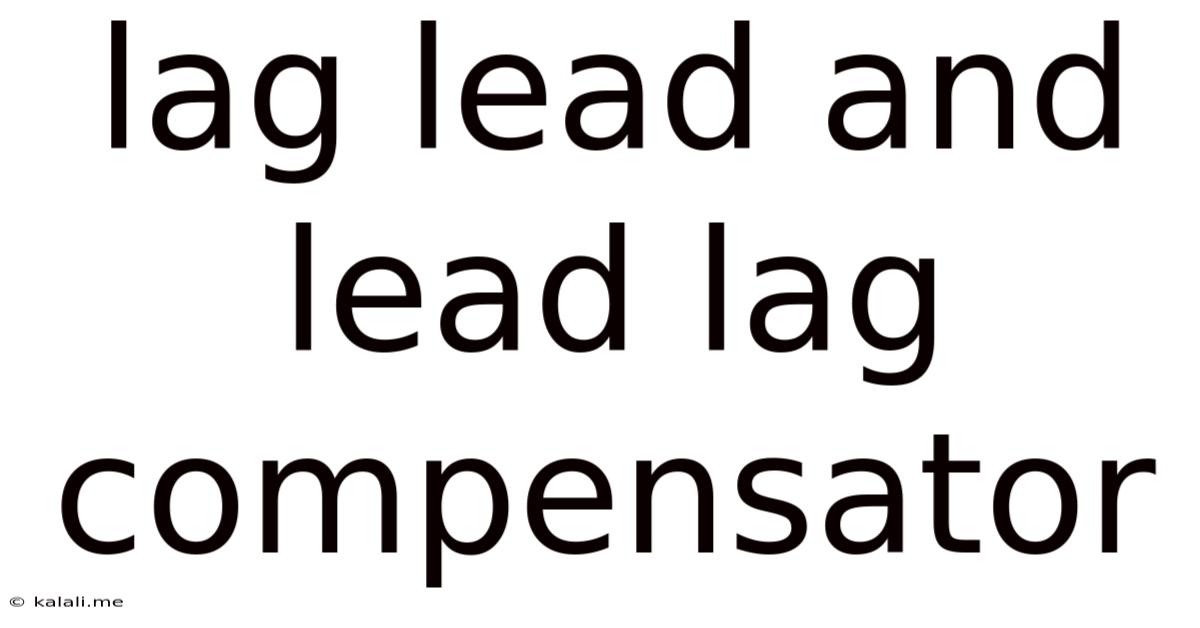Lag Lead And Lead Lag Compensator
Kalali
Jun 11, 2025 · 4 min read

Table of Contents
Understanding Lag, Lead, and Lead-Lag Compensators in Control Systems
This article delves into the crucial concepts of lag, lead, and lead-lag compensators within the realm of control systems engineering. We'll explore their functionalities, design considerations, and practical applications, providing a comprehensive understanding for both beginners and those seeking a refresher. This will cover the core aspects of these compensators and their impact on system performance.
What is a Compensator?
In control systems, a compensator is a device or algorithm designed to improve the performance of a control loop. It modifies the transfer function of the system to achieve desired characteristics like faster response times, reduced overshoot, or improved stability. Lag, lead, and lead-lag compensators are common types achieving these goals through specific adjustments to the system's frequency response.
Lag Compensator: Enhancing Stability and Reducing Steady-State Error
A lag compensator, also known as an integral compensator, primarily focuses on improving the steady-state accuracy of a control system. This is achieved by reducing the steady-state error, the difference between the desired output and the actual output at a constant state.
How it works: A lag compensator introduces a pole and a zero to the system's transfer function. The pole is placed closer to the origin than the zero, resulting in a reduction of gain at high frequencies and a boost at low frequencies. This boost at low frequencies is key to improving the system's response to low-frequency signals, effectively reducing the steady-state error.
Key Characteristics:
- Reduces steady-state error: Excellent for applications requiring precise tracking of setpoints.
- Improves stability margins: Although not its primary function, it can contribute to improved stability.
- Slows down transient response: The addition of the pole slightly slows down the speed of the system's transient response.
Lead Compensator: Speeding Up Response and Improving Transient Performance
A lead compensator primarily aims to enhance the speed and responsiveness of a control system. It achieves this by increasing the system's bandwidth and improving its transient response.
How it works: A lead compensator introduces a zero and a pole to the system’s transfer function. However, unlike the lag compensator, the zero is placed closer to the origin than the pole. This results in an increase of gain at high frequencies and reduced gain at low frequencies. The increase in high-frequency gain accelerates the system's response to changes in the input signal.
Key Characteristics:
- Faster transient response: Significantly reduces rise time and settling time.
- Increased bandwidth: Allows the system to respond effectively to faster changes in the input.
- Improved stability: Can help stabilize systems that exhibit sluggish or oscillatory behavior.
- Potential for increased overshoot: Care must be taken in design to avoid excessive overshoot.
Lead-Lag Compensator: A Balanced Approach
A lead-lag compensator combines the benefits of both lag and lead compensators. It addresses both steady-state error and transient response simultaneously, offering a more comprehensive solution for many control system applications.
How it works: A lead-lag compensator involves placing both a zero-pole pair (lead) and another zero-pole pair (lag) in the system. The placement of these poles and zeros is carefully calculated to achieve the desired balance between steady-state accuracy and transient response.
Key Characteristics:
- Reduces steady-state error: Similar to a lag compensator.
- Faster transient response: Similar to a lead compensator.
- Improved stability: Often provides a better stability margin than using a lead or lag compensator alone.
- Requires careful design: Proper placement of poles and zeros is crucial for optimal performance.
Design Considerations for all Compensators:
The design of lag, lead, and lead-lag compensators involves careful selection of the locations of the poles and zeros in the s-plane (complex frequency plane). This is often done through root locus analysis, Bode plots, or frequency response techniques. The specific location depends on the desired performance characteristics and the constraints of the system.
Conclusion:
Lag, lead, and lead-lag compensators are essential tools in control systems engineering. By understanding their individual functionalities and how they interact with a system's dynamics, engineers can design and implement effective control strategies to achieve desired performance specifications. Choosing the appropriate type of compensator depends heavily on the specific requirements of the application and the characteristics of the controlled system. Careful design and analysis are critical to ensure optimal performance and stability.
Latest Posts
Latest Posts
-
How Many Tablespoons Are In 1 2 Ounce
Jul 01, 2025
-
How To Beat Level 29 On 40x Escape
Jul 01, 2025
-
Theres A Leak In This Old Building Lyrics Meaning
Jul 01, 2025
-
If I M 19 What Year Was I Born
Jul 01, 2025
-
How Many Pounds Are In 900 Grams
Jul 01, 2025
Related Post
Thank you for visiting our website which covers about Lag Lead And Lead Lag Compensator . We hope the information provided has been useful to you. Feel free to contact us if you have any questions or need further assistance. See you next time and don't miss to bookmark.